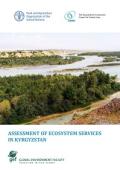
This book was prepared upon an initiative of the GEF/FAO project on “Sustainable Management of Mountainous Forest and Land Resources under Climate Change Conditions”. It is based on the international experience in implementing the principles of ecosys- tem services provision, the results of CAREC projects on the assessment of ecosystem services and PES, the report of the UNDP/UNEP Poverty and Environment Initiative on the assessment of ecosystem services of the Chon Kemin State Natural Park and the Karakol National Park, and other materials.

This publication presents the first quantitative assessment of the impact of climate change on a protected area in Mongolia and helps identify adaptation measures to build climate resilience for biodiversity conservation, livelihoods, and tourism.
This paper presents an ex-ante cost-benefit analysis of large-scale rangeland restoration through the Hima system within the Zarqa River Basin, drawing on experience from a pilot initiative by the International Union for Conservation of Nature (IUCN) and the Jordanian Ministry of Agriculture since 2010. The ecosystem services that arise from rangeland restoration are valued using a combination of stated preference, avoided costs, replacement cost, and market prices approaches.
The New Zealand Mineral Monetary and Physical Stock Account, 1994-2000, presents the asset value of minerals in New Zealand. It focuses on minerals that are presently economically utilised in New Zealand, including metallic minerals (gold, silver, and ironsand concentrate) and non-metallic minerals (aggregate, clay, limestone, dolomite, and others).
Chapter 22 of the supplementing technical report, titled Economic Values from Ecosystems, presents an economic assessment of the contribution of ecosystem services on human well-being, following the methodology set out for the UK NEA. Overall, the chapter makes the case that ecosystems and their services are economically very significant at the national scale, underlining the relevance of conservation and efficient management.
This working paper details the results for both the total value of Dutch oil and gas reserves and the government appropriation of the resource rent from extraction. This is part of a larger effort by Eurostat to conduct valuations on sub-soil assets as part of their work to develop environmental accounts linked to national accounts. The methods and data presented in this paper can support both researchers and compilers of accounts for subsoil assets.

This chapter of Conservation for the Anthropocene Ocean provides a discussion on experiences with using transdisciplinary approaches and ecosystem services to inform two government-led spatial planning processes in the Caribbean: Integrated Coastal Zone Management in Belize and Sustainable Development Planning in The Bahamas.
This study showcases the German experience with developing an accounting system that embeds a high proportion of economic and environmental indicators of the national Strategy on Sustainable Development. It then derives a more general three-step approach for such an integration exercise: (1) revision of the indicator set, (2) expansion of the accounting system to meet new data needs, and (3) development of appropriate modelling approaches for an integrated environmental, social, and economic analysis.
This working paper presents the results of work by Statistics Austria on an economy-wide material balance for 1997, as well as a time series of resource use indicators such as Direct Material Inputs (DMI) and Direct Material Consumption (DMC) for 1960-1997. It is thus an essential contribution to the development of economy-wide material flow accounts and balances and can serve as an example for those wishing to implement similar analyses.
In an effort to better understand the interactions between economic activity and the environment, this report computes the CO2 emissions caused by French domestic demand in 2005, taking into account both the national productive system as well as any activities abroad, such as imports. The aggregate figure calculated amounts to just over 550 million tonnes (9 tonnes per year per inhabitant). This number is then broken down to show that 75 percent of these emissions are produced by household consumption expenditure, mainly on housing, transport, and food; 10 percent are produced by general government consumer expenditure; and 15 percent by investment.
